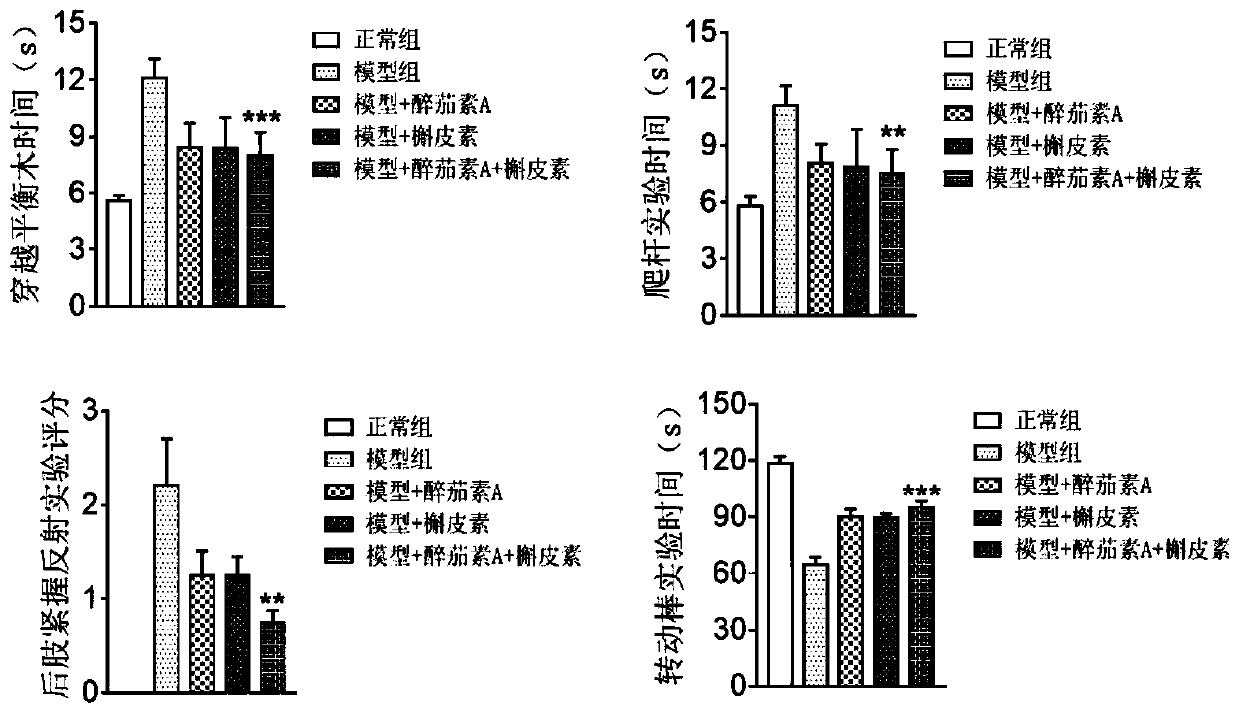A kind of medicinal composition containing ashwagandha and application thereof
A kind of technology of ashwagandha, composition
- Summary
- Abstract
- Description
- Claims
- Application Information
AI Technical Summary
Problems solved by technology
Method used
Image
Examples
Embodiment 1
[0040] To treat Parkinson's disease:
[0041] (Related Behavioral Indicators)
[0042] Establishment of MPTP-induced Parkinson's disease model: After the mice were adaptively fed for 1 week, C57BL / 6 mice weighing more than 22 g were randomly selected, and 30 mg / kg MPTP solution was injected intraperitoneally, once a day, for 5 consecutive days.
[0043] At this time, the MPTP injection group (hereinafter referred to as the model group) was randomly divided into 4 groups, namely the model + control solvent group, the model + withaferin A group, the model + quercetin group, and the model + withaferin A + quercetin group. Group. Among them, each group of mice was injected intraperitoneally with withaferin A (20 μg / kg), quercetin (30 mg / kg), and the combination of withaferin A+quercetin (withaferin A 10 μg / kg, quercetin 15 mg / kg). kg), and an equal volume of control solvent.
[0044] After 7 days of intraperitoneal injection of each group of drugs and control solvent, the chang...
Embodiment 2
[0079] A mouse model of Parkinson's disease induced by MPTP was established (the method is the same as in Example 1). The MPTP injection group (hereinafter referred to as the model group) was randomly divided into 4 groups, namely the model + control solvent group, the model + withaferin A group, the model + quercetin group, and the model + withaferin A + quercetin group. Among them, each group of mice was injected intraperitoneally with withaferin A (20 μg / kg), quercetin (3 mg / kg), and the combination of withaferin A+quercetin (withaferin A 10 μg / kg, quercetin 1.5 mg / kg), and an equal volume of control solvent.
[0080] After 7 days of intraperitoneal injection of each group of drugs and control solvent, the changes of behavioral indexes in each group were detected. The method of balance beam experiment is the same as embodiment 1, and the results are shown in Table 5.
[0081] Table 5 Balance Beam Experimental Results
[0082]
[0083] The rod climbing test method is ...
Embodiment 3
[0094] Protective effect on dopaminergic neurons in substantia nigra and striatum:
[0095] Tyrosine hydroxylase (TH) is the rate-limiting enzyme of dopamine synthesis in the brain, and its level represents the ability of mice to synthesize dopamine. Therefore, tyrosine hydroxylase is often used as an indicator of dopamine secretion ability in mice.
[0096] After the establishment of the MPTP model, the establishment of the MPTP model and the dosage of the drug were the same as in Example 1. After 7 days of intraperitoneal injection of the drug and the control solvent in each group, the levels of tyrosine hydroxylase in the substantia nigra pars compacta of mice in each group were detected using immunohistochemical technology , the results are shown in Table 9.
[0097] The results were: compared with the normal group, the number of TH positive neurons in the substantia nigra pars compacta of the mice in the model group decreased significantly, that is, obvious dopaminergic n...
PUM
 Login to View More
Login to View More Abstract
Description
Claims
Application Information
 Login to View More
Login to View More - R&D
- Intellectual Property
- Life Sciences
- Materials
- Tech Scout
- Unparalleled Data Quality
- Higher Quality Content
- 60% Fewer Hallucinations
Browse by: Latest US Patents, China's latest patents, Technical Efficacy Thesaurus, Application Domain, Technology Topic, Popular Technical Reports.
© 2025 PatSnap. All rights reserved.Legal|Privacy policy|Modern Slavery Act Transparency Statement|Sitemap|About US| Contact US: help@patsnap.com



